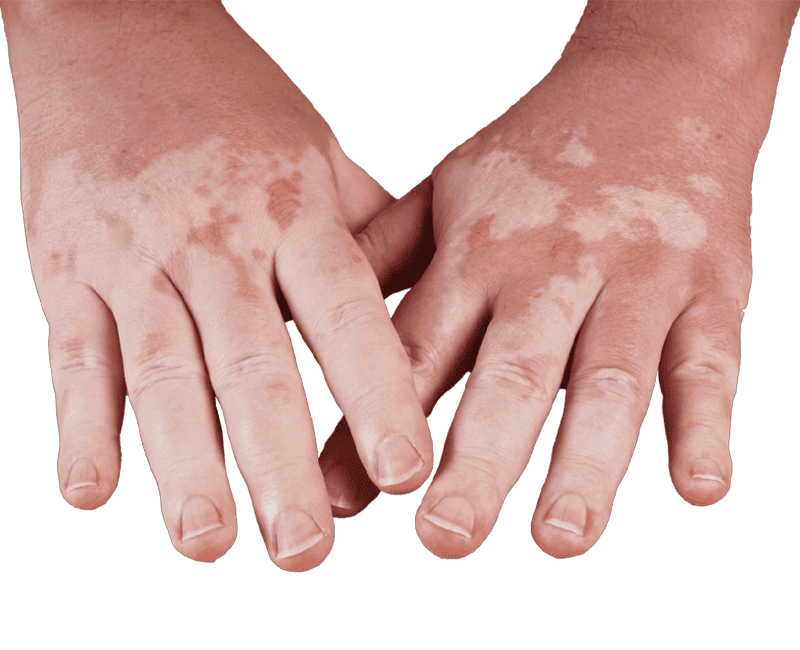
Vitiligo is a chronic skin condition that causes depigmentation in patches across the skin. This condition arises when melanocytes, the cells responsible for producing pigment (melanin), are destroyed, resulting in white or depigmented areas. Acral vitiligo, a variant of this condition, predominantly affects the distal extremities such as the hands, feet, fingers, and toes. This variant can be particularly challenging to treat and often presents significant psychosocial challenges for patients.
Acral vitiligo is a subtype of vitiligo that involves depigmentation of the skin on the extremities—specifically, the fingers, toes, hands, and feet. This type of vitiligo is often more resistant to treatment compared to other forms, and the skin in these areas can take longer to respond to therapies aimed at restoring pigmentation. The term “Acral” refers to the peripheral or outermost parts of the body, such as the limbs and extremities.
Acral vitiligo can manifest in patients with either segmental vitiligo (limited to one area of the body) or non-segmental vitiligo (which can spread symmetrically across different parts of the body). Due to the prominence of the hands and feet in daily life, patients with acral vitiligo often experience heightened emotional distress as these areas are frequently visible to others.
Vitiligo, including the acral type, is an autoimmune disorder in which the immune system mistakenly attacks the body’s melanocytes. However, the exact mechanism that triggers this autoimmune reaction is still not completely understood. Various factors have been proposed as potential contributors to the development of acral vitiligo, including:
The most characteristic symptom of Acral vitiligo is the appearance of white or depigmented patches on the hands, fingers, feet, and toes. These patches may start as small spots but can expand over time. In many cases, these patches are symmetrical, although they can also appear asymmetrically.
Acral vitiligo can progress slowly, but in some individuals, the depigmentation can accelerate, particularly after physical trauma or stress. In certain cases, depigmentation can spread to other areas of the body, including the face, neck, and trunk, depending on the subtype of vitiligo.
While vitiligo is not physically harmful, the emotional and psychological impact can be significant, particularly for acral vitiligo. The visibility of the condition, especially on the hands and feet, can lead to feelings of self-consciousness, social anxiety, and depression. Many patients report difficulties with self-esteem due to the cosmetic nature of the condition, and some may withdraw from social activities or experience discrimination. Support from healthcare providers, mental health professionals, and support groups can be crucial in helping individuals cope with the psychological aspects of this condition.
Diagnosis of acral vitiligo is primarily clinical, meaning that it is often made based on visual examination by a Dermatologist. Dermatologists may use a Wood’s lamp (a type of ultraviolet light) to highlight areas of depigmentation that might not be visible under normal lighting. This can help in distinguishing vitiligo from other skin conditions that cause depigmentation.
In some cases, a skin biopsy might be performed to rule out other conditions or to confirm the absence of melanocytes in the affected area. Blood tests may also be conducted to assess for autoimmune markers, as vitiligo is sometimes associated with other autoimmune conditions, such as thyroid disorders or Type 1 Diabetes.
The treatment for Vitiligo, particularly Acral Vitiligo, can be challenging, and no cure currently exists. However, there are various treatment modalities aimed at repigmenting the skin or at least halting the progression of depigmentation.
Research into vitiligo, including the acral subtype, is ongoing. New insights into the autoimmune mechanisms, genetic factors, and environmental triggers involved in vitiligo continue to emerge. In particular, scientists are exploring the use of biologics—medications that target specific parts of the immune system—as potential treatments for vitiligo. Additionally, regenerative medicine, stem cell therapies, and gene-editing technologies may hold promise for future treatments.
Acral vitiligo is a complex and often challenging variant of vitiligo that primarily affects the extremities. While it may be more resistant to treatment than other forms, there are numerous therapeutic options available that can help manage the condition. The psychosocial impact of this condition should not be overlooked, and comprehensive care should include support for the emotional well-being of patients. Ongoing research continues to bring hope for more effective treatments and, potentially, a cure in the future.
Address:
Door No. 8-2-293/82/A/725/A, Beside FMS INTERNATIONAL DENTAL CENTER Road No. 37, Hitech City Rd, near Daspalla Hotel, CBI Colony, Jubilee Hills, Hyderabad, Telangana 500033
Email: [email protected]
Email: [email protected]